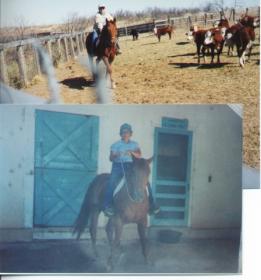I’ll keep the back story as brief as I can. My parents are keeping a horse for my aunt who just recently got out of a relationship. Most likely, this is going to be a permanent “keeping” of the horse, which is fine because my parents have the room and my mom wanted an extra horse besides her colt.
This gelding is around 10 years old, although he wasn’t gelded until he was about 6. He is registered AQHA. He supposedly was trained really well and all that, and he was actually at a “trainer’s” this summer before my aunt brought the horse to my parent’s place.
I’m not impressed with his training.
I rode him for the first time this past weekend so I could see a few things for myself. My mom would tell me how when she asks him to gallop, he puts his head WAY down.
From my one experience on him, he seems like a nice enough horse but he is certainly not suitable for my aunt who hasn’t ridden regularly in many years. He needs a confident and assertive rider. He bucked twice while I was making him work a little bit (he’s done the same to my mom) but nothing major and I just rode him through it and made him keep working.
He doesn’t really seem to know leg aids very well. It was even difficult to get him to do a nice sidepass from a standstill. (He likes to back up.) He also seemed to fight the bit a little. We’re not sure when he has had his teeth done (or if ever) and I’ve had a hard time convincing my mom to take her own colt in to get his teeth done … so we’ll see if I can get her to get the both of them done. I’ve been nagging her for a while.
I was riding him in a short shank bit with a single joint in the smooth mouthpiece. Eventually during our ride, I clipped the reins directly to the mouthpiece to make it a snaffle and that made a HUGE difference when I am trying to do direct rein work with him. Hurt my stopping ability a little bit without the shank, but still totally manageable.
Best I can tell that when you ask him to lope, he immediately puts his head WAY down which causes all his weight to go on his front end, and makes for a rough ride. Seems like at some point he was “trained” to do this (quite obviously, trained incorrectly) for a headset. If you put rein pressure on both reins to slow him down, he just puts his head even lower which makes his transition from a lope to a trot very rough.
So my question in all my rambling: What is the best way to FIX this?
For the brief moments when I got him to lope normally, he has a really nice lope. But once that head goes down again, it loads his front end.
We’re a little limited in how we can work him right now, being it’s winter and my parents live in the middle of no where. So basically just trying to find a spot where the ground isn’t icy or full of frozen snow clumps.
Another problem he has is that he doesn’t follow his nose. There were times when I was loping him, trying to figure him out, I had his nose to the left yet he was traveling to the right. It helped a lot to make that small change on his bit (make it a snaffle) but he’s going to need to re-learn how to follow his nose.
Would also help if he could do leg cues, which will have to be worked on as well.
Essentially, he is NOT well-trained like we thought he was going to be.
I think one of the best things for him (once spring rolls around) is to just let him lope for a loooooong time on a loose rein. So that maybe he learns he doesn’t have to put his head in that “frame” and we aren’t going to ask him to do that.
I won’t really be the one riding him that much because my parents live 100 miles away, but a few pointers I have come up with for my mom while loping him
- use one rein at a time (not both together)
- do few circles (he hates them and that’s probably what he had to do in the past a lot, and probably associates that with the headset) but do lots of serpentines and “stair-case” patterns, again, using one rein at a time to change directions
- drive him forward (he seemed to do better with his head set when I really drove him forward with my legs)
- work on lateral leg cues
- work on following his nose
But I was just looking for any other specific things we can do to help bring that head up and into a normal position again.
…This is what happens when trainers don’t know what they are doing!!!


